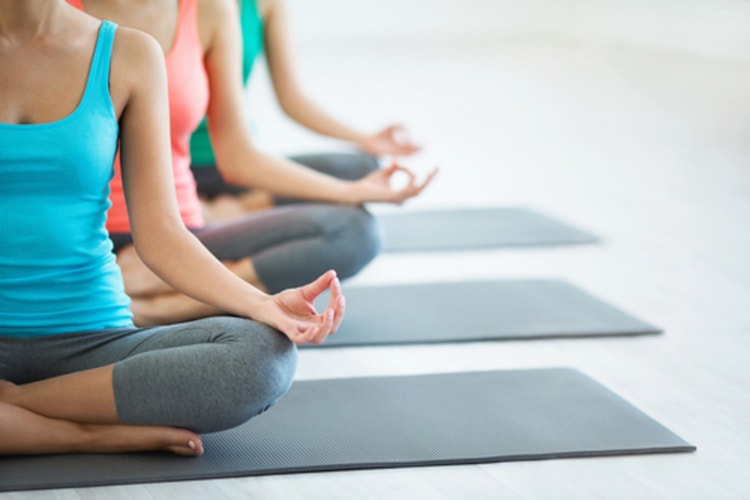Three Things to Do to Stress Less

In honor of National Stress Awareness Month in April …
If you think about it, relaxation is like a muscle. It’s different from your other muscles, of course, and therefore training it requires different tools. That’s where meditation comes in. It can be a valuable tool for managing stress, and with practice, you’ll strengthen this “muscle.”
Here are three meditation techniques that may help you cope with different stresses, from the suppression of the parasympathetic nervous system (this is the part of your body that controls your heart rate and your temperature) to those never-ending worries. Note that unlike physical strength and conditioning, there’s more than one “right” way to meditate.
Enjoy playing with these techniques, both in formal sit-down meditations and throughout your day.
1. Body Scan
Mindfulness isn’t just a new-age buzzword. It’s the practice of paying deliberate attention. The body scan is a mindfulness meditation technique adapted by Dr. Jon Kabat-Zinn for the Mindfulness-Based Stress Reduction Program. Paying attention deliberately — or, dare I say it, mindfully — means showing up for every moment, instead of living on autopilot or getting lost in (sometimes stressful) thoughts. Mindfulness meditations may improve overall well-being and coping, which is essential to stress management. A body scan is just lying still on your back, and moving your focus from the tips of your toes all the way to the top of your head. It’s a way to acknowledge different regions of your body, without the intention of changing anything.
Sit-down meditation: Here’s an easy, seven-minute body scan meditation video to get you started. You’ve got seven minutes, right? All you have to do is listen and follow along!
To challenge yourself, you can do a formal, dedicated Body Scan meditation every day for a month. Like your workouts, meditation is called a “practice” for a reason: it takes time to build the muscle. There are many guided body scans to try, including many by Dr. Kabat-Zinn himself. Enjoy.
Throughout your day: This technique can be used to cope with in-the-moment-stress any time. Take a deep breath and focus in on your body. A quick scan from head to toe, allowing whatever sensations you notice to simply exist, can be a great way to relax.
2. Deep Breathing
When you’re stressed, your body and brain are caught in a feedback loop of ever-increasing tension. Messages from the brain tell the body to tense, and a tense body sends messages back to the brain, which manifest in the form of worry, rumination and unpleasant thoughts. This stress response always involves shallow breathing. Break that feedback loop and engage your parasympathetic nervous system (the relaxation system) with deep breathing meditations.
Sit-down meditation: Set a timer for 10-30 minutes. Get comfortable. With your shoulders back, close your eyes and breathe deeply. Breathe in through the nose — so your belly expands — and out through the mouth, slowly. Count your breaths, counting backward from 23. If you get to zero, start at 23 and count down again.
You’re only objective with this exercise is to be “with the breath.” If you get distracted, don’t worry. You can always simply return to the breath.
Throughout your day: Focused breathing can be incorporated into any activity, especially physical ones. It’s fundamental to yoga. Take a moment to really breathe: that means slow breaths that cause your belly to expand outward. Try doing this six times per day for a week, in addition to your sit-down meditation. This can build a habit of parasympathetic engagement; which is a very useful habit of relaxation.
3. Loving Kindness
Loving Kindness, or Metta meditation, is a heart-based meditation. Loving Kindness may provide many health benefits, including many measurable physiological improvements. It’s been shown to increase positive emotions and decrease negative emotions, including those related with stress.
Sit-down meditation: Set a timer. Begin by settling yourself, closing your eyes and breathing deeply. Imagine you are breathing into and out of your heart, in the center of your chest. Send Loving Kindness by simply saying (and meaning) these words:
Always start by sending Loving Kindness to yourself … no matter how difficult. Then, send it to others. It’s easiest to send it to those you already love, but you can send it to anyone.
Throughout your day: Breathe from the heart and send Loving Kindness the next time you’re in the shower, running on the treadmill or even stuck in traffic.
Get meditating
You may be surprised to learn that the point of meditation is not just to relax. The point of meditation is to enable us to cope with the mysteries of human existence, to give us tools to understand ourselves, and to connect us with meaning in our lives. Relaxation is a happy side effect and reason enough to begin the journey of meditation. May your journey be a good one.